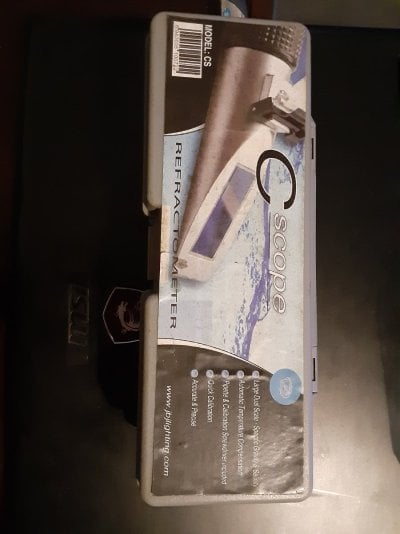Let me preface this by saying that no consumer device measures salinity in a reef environment with any true precision. I see a lot of people talk about it does not matter if you calibrate your refractometer with distilled water or calibration solution. Last time this popped up I tried explaining the calibration continuum of these meters but I am not sure everyone understood. So yesterday day when I was recalibrating my refractometer I did my best to capture a few photos. Calibration solution was new and confirmed on a YSI (conductivity method) to be 35.1 ppt.

Both meters had drifted slightly from their previous calibration ~ 2 months ago using the above method... I know I'm lazy. What's most notable is meter 2 is off 0 by 6ppt while still correctly showing the calibration solution as 35ppt. Had the meter been calibrated with distilled water, 35ppt would have shown as 29ppt. I mentioned this because quite a few people have issues that appear to be salinity related while insisting it cannot be because they just calibrated their meter. Meter 1 faired a little better despite having drifted 1ppt up. Had it been calibrated with distilled water, even accounting for the drift, it would read 35ppt as 32ppt. As mentioned earlier, no method is going to give any real precision, but using 0 as a calibration just compounds error. So my point? I guess the upshot is:
Once opened calibration solution is only good for a very short time (days at most).
Meters do drift which is why even on commercial equipment they are required to be recalibrated and the method logged.
If you are testing for 35ppt, calibrate with a solution close to that number or even better both sides of your target.
Floaty things and shockey meters have different drawbacks that insure the same errors is precision. Do not just assume any single method gives you an accurate idea of the true number. Oh! And most important. ATC is not a brand.
Both meters had drifted slightly from their previous calibration ~ 2 months ago using the above method... I know I'm lazy. What's most notable is meter 2 is off 0 by 6ppt while still correctly showing the calibration solution as 35ppt. Had the meter been calibrated with distilled water, 35ppt would have shown as 29ppt. I mentioned this because quite a few people have issues that appear to be salinity related while insisting it cannot be because they just calibrated their meter. Meter 1 faired a little better despite having drifted 1ppt up. Had it been calibrated with distilled water, even accounting for the drift, it would read 35ppt as 32ppt. As mentioned earlier, no method is going to give any real precision, but using 0 as a calibration just compounds error. So my point? I guess the upshot is:
Once opened calibration solution is only good for a very short time (days at most).
Meters do drift which is why even on commercial equipment they are required to be recalibrated and the method logged.
If you are testing for 35ppt, calibrate with a solution close to that number or even better both sides of your target.
Floaty things and shockey meters have different drawbacks that insure the same errors is precision. Do not just assume any single method gives you an accurate idea of the true number. Oh! And most important. ATC is not a brand.

















